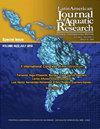Bases to inform a genetic line of whiteleg shrimp Penaeus (Litopenaeus) vannamei of Mexican origin
IF 0.8
4区 农林科学
Q3 FISHERIES
Latin American Journal of Aquatic Research
Pub Date : 2024-02-29
DOI:10.3856/vol52-issue1-fulltext-3066
引用次数: 0
Abstract
The whiteleg shrimp Penaeus (Litopenaeus) vannamei is one of the most relevant aquaculture species in Latin America and globally. Among several elements, the improvement of its production depends on the larval genetic quality produced in commercial hatcheries. A strategy for achievement is setting up a long-term management plan that includes the genetic settlement of a breeding population with broad genetic variability and reduced inbreeding levels and the design of adequate management and crossbreeding schemes. The settlement of the breeding population requires a detailed characterization of the genetic composition and diversity of the breeding line(s) that are being managed. The present study evaluated the genetic composition of six wild populations from the southern and northern coasts of the Mexican Pacific (Oaxaca, Guerrero, Nayarit, and Sinaloa) and 56 breeding lots maintained in commercial hatcheries. The genetic profiles of a low-density SNP marker panel (171 and 152 loci for the wild and hatchery-reared groups, respectively) were used to estimate genetic diversity and differentiation within and among samples. The wild population presented significant genetic differences between southern and northern Pacific locations. Although these populations showed higher diversity levels than the cultivated stocks, the genetic pool of the total 56 lots was highly variable with low inbreeding levels. The genetic characteristics of the analyzed populations and cultivated stocks warrant the constitution of a Mexican-origin breeding line with future potential for selection to the environmental conditions of the northwestern region of Mexico.为墨西哥白对虾(Penaeus (Litopenaeus) vannamei)遗传品系提供依据
南美白对虾(Penaeus (Litopenaeus) vannamei)是拉丁美洲和全球最重要的水产养殖品种之一。其产量的提高取决于商业孵化场生产的幼体遗传质量。实现这一目标的战略是制定一项长期管理计划,其中包括对具有广泛遗传变异和降低近亲繁殖水平的养殖种群进行遗传定居,以及设计适当的管理和杂交计划。要解决育种群体的问题,就必须详细分析所管理的育种品系的遗传组成和多样性。本研究评估了墨西哥太平洋南部和北部海岸(瓦哈卡、格雷罗、纳亚里特和锡那罗亚)的六个野生种群和商业孵化场饲养的 56 个育种批次的遗传组成。低密度 SNP 标记组(野生组和孵化组分别有 171 和 152 个位点)的遗传图谱用于估计样本内部和样本之间的遗传多样性和分化。太平洋南部和北部的野生种群之间存在明显的遗传差异。虽然这些种群比人工养殖种群显示出更高的多样性水平,但总计 56 个批次的基因库变化很大,近亲繁殖水平很低。分析的种群和栽培种群的遗传特征证明,墨西哥原种育种品系的构成具有未来针对墨西哥西北部地区环境条件进行选育的潜力。
本文章由计算机程序翻译,如有差异,请以英文原文为准。
求助全文
约1分钟内获得全文
求助全文
来源期刊

Latin American Journal of Aquatic Research
FISHERIES-MARINE & FRESHWATER BIOLOGY
CiteScore
1.70
自引率
10.00%
发文量
44
审稿时长
4-8 weeks
期刊介绍:
Latin American Journal of Aquatic Research- LAJAR is the continuation of the journal Investigaciones Marinas (1970-2007) and is published since 2008 by the Escuela de Ciencias del Mar, Facultad de Ciencias del Mar y Geografía of the Pontificia Universidad Católica de Valparaíso. LAJAR is an “Open Access” journal that publishes in English language, original research articles, reviews and short communications on aquatic science, which contain the results of research conducted in aquaculture or in oceanic and coastal marine waters of Latin America.
The following topics are considered: Physical Oceanography, Chemical Oceanography, Marine Biogeochemistry, Marine Pollution and Toxicology, Marine Geology and Geophysics, Biological Oceanography, Fisheries and Aquaculture.
 求助内容:
求助内容: 应助结果提醒方式:
应助结果提醒方式:


